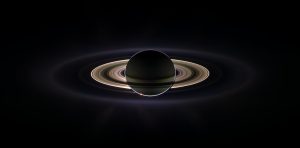Sep 15 2017
Cassini’s Dramatic End
 The Cassini probe to Saturn has been considered one of the most successful space missions in history. Today it will plunge into the upper atmosphere of Saturn. As the atmosphere gets thicker on its way down the probe will begin to tumble from the turbulence, until it is ripped apart by the violent forces and finally melts in the intense heat of the gas giant. (As I am writing this there are just 30 minutes left.)
The Cassini probe to Saturn has been considered one of the most successful space missions in history. Today it will plunge into the upper atmosphere of Saturn. As the atmosphere gets thicker on its way down the probe will begin to tumble from the turbulence, until it is ripped apart by the violent forces and finally melts in the intense heat of the gas giant. (As I am writing this there are just 30 minutes left.)
This is the intended fate of the probe. It was launched in 1997, took seven years to get to Saturn, and has been studying the planet and its moons for 13 years. It has dramatically improved our knowledge of the Saturn system. Cassini was the first probe to orbit Saturn. Prior to that, Pioneer and Voyager had performed flybys, which gave us quick glimpses but did not allow for extended study.
In addition to being a feat of science and engineering, Cassini surpassed expectations. Its original mission profile was for four years. It was able to have two mission extensions, for a total of 13 years. Now it is almost completely out of fuel – its mission is over.
NASA debated what to do with the probe when it was done. They could have left it in Saturn orbit, but they decided that would have no scientific value. I don’t know if they could have sent it on a trajectory away from the solar system. It may not have been possible to give it enough velocity to break from the Sun’s gravity.
So they decided to end Cassini’s life with a dramatic plunge into Saturn itself. In preparation they had Cassini transmit all of its remaining data to Earth. It has now given us all it has to give – except for what little data it can send during its grand finale. Cassini can transmit only about 30 kilobits per second, which is not enough to send pictures, so the cameras will be off. It will still be transmitting live data from other instruments, however – one last burst of scientific information.
The plunge also allowed NASA to send Cassini on a highly elliptical orbit that took it closer and closer to the planet, exploring the region between the rings and the atmosphere for the first time. Its final orbit will bring it within the atmosphere, resulting in its fiery death.
Cassini has brought us a treasure trove of amazing images of Saturn, including the most detailed pictures of its rings, and polar views of the planet revealing the strange hexagonal cloud pattern. We also learned that Enceladus has liquid water under its icy surface, and that geysers occasionally spurt this water out into space, creating the opportunity for a future mission to sample this water looking for signals of life.
Titan, too, has turned out to be even more interesting than hoped.
“Data from Cassini-Huygens revealed Titan has lakes and seas of liquid methane and ethane, replenished by rain from hydrocarbon clouds.
The mission also provided evidence that Titan is hiding an internal, liquid ocean beneath its surface, likely composed of water and ammonia.”
I’m watching the livestream now. Mission control is busy, but everyone seems calm, doing their job quietly and professionally. It’s four minutes to the end. They just went to high-rate control, meaning they are having to fight turbulence in order to keep the transmitter pointed at Earth. They are operating at “half a hair dryer” worth of energy.
They lost the signal pretty much right when predicted, at 11:55:46, and end of mission was officially called.






